A) diagram M
B) diagram H
C) diagram K
Correct Answer

verified
Correct Answer
verified
Multiple Choice
If a scientist recorded the size, birth rate, and age structure of an owl population over the last 20 years, he is MOST likely a(n) :
A) demographer.
B) embryologist.
C) botanist.
D) mathematician.
E) evolutionary biologist.
Correct Answer

verified
Correct Answer
verified
Multiple Choice
The figures below represent three hypothetical populations; each circle is an individual.  Select the pattern above that describes the following scenario: This is a social species.
Select the pattern above that describes the following scenario: This is a social species.
A) diagram M
B) diagram H
C) diagram K
Correct Answer

verified
Correct Answer
verified
Multiple Choice
Phylogenies suggest that Anolis lizards colonized Hispaniola:
A) once.
B) twice.
C) five or six times.
D) a dozen times or more.
Correct Answer

verified
Correct Answer
verified
Multiple Choice
Most populations demonstrate _____ growth, in which the population size increases exponentially until it levels off near the K value of the habitat for that species.
A) exponential
B) intrinsic
C) logistic
D) extrinsic
E) logarithmic
Correct Answer

verified
Correct Answer
verified
Multiple Choice
Based on mortality rates shown below in Figure 46.11, which stage of the lime swallowtail life cycle would you expect to be the SHORTEST? a.
b.
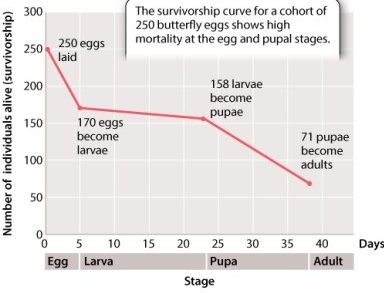
A) the egg stage
B) the larval stage
C) the pupal stage
Correct Answer

verified
Correct Answer
verified
True/False
The size of a population of frogs is significantly below the population size that the environment can support. This could be the result of frog parasites and/or predators.
Correct Answer

verified
Correct Answer
verified
Multiple Choice
You are surveying biodiversity on a new island chain. You have counted the number of bat species on one island already. The next island is smaller and farther from the mainland than the one you have just surveyed. According to the theory of island biogeography, the total number of its bat species should be _____ than on the current island because the rate of immigration to the new island should be _____ and the rate of extinction should be _____. Refer to Figure 46.17. a.
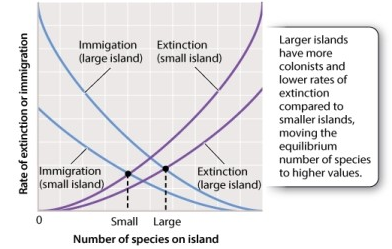 b.
b.
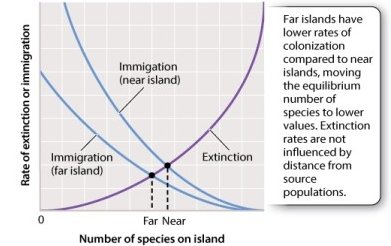
A) smaller; higher; lower
B) smaller; lower; higher
C) greater; higher; lower
D) greater; lower; higher
Correct Answer

verified
Correct Answer
verified
Multiple Choice
Recall that the age structure histogram (for humans) of India is shaped like a pyramid (Figure 46.8) . What does this tell you about India's population? 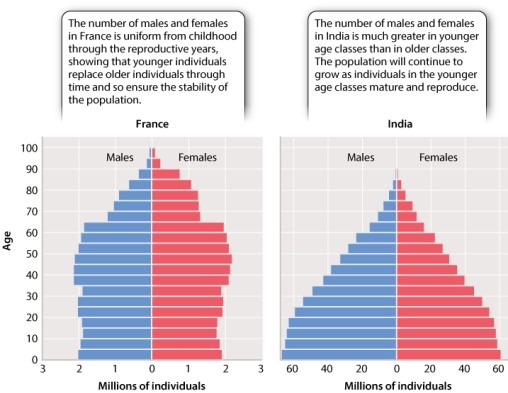
A) It is shrinking.
B) It is growing.
C) It is relatively constant.
D) It is currently shrinking, but will increase over the next few years.
E) It is currently growing, but will decrease over the next few years.
Correct Answer

verified
Correct Answer
verified
Multiple Choice
A population that has a high mortality earlier in the life cycle than later in the life cycle would have a Type _____ survivorship curve.
A) I
B) II
C) III
D) IV
Correct Answer

verified
Correct Answer
verified
Multiple Choice
Consider a population undergoing logistic growth. 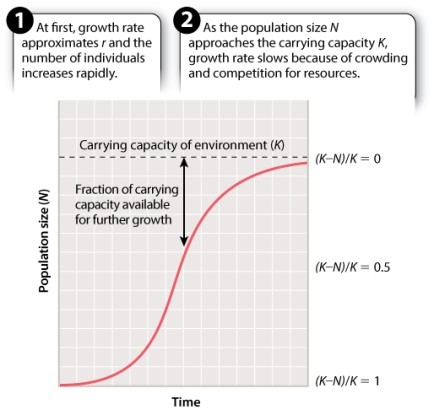 When are the most individuals added to the population per unit time?
When are the most individuals added to the population per unit time?
A) (K-N) /K = 1
B) (K-N) /K = 0.75
C) (K-N) /K = 0.5
D) (K-N) /K = 0.25
E) (K-N) /K = 0
Correct Answer

verified
Correct Answer
verified
Multiple Choice
If you were a conservation biologist in charge of the recovery plans for an endangered species, which would you prefer to find within that species-an even distribution of age classes or a pyramid-shaped age distribution? Why?
A) an even distribution because then the population is stable
B) a pyramid-shaped distribution because then the population is stable
C) an even distribution because this mean the population will grow
D) a pyramid-shaped distribution because this means the population will grow
Correct Answer

verified
Correct Answer
verified
Multiple Choice
A group of field biologists goes out to mark beetles living in an area around a local pond in order to estimate population size. They capture 500 beetles on the first day. They return the following day and catch a total of 400 individuals, 200 of which are marked. What is the estimated population size for the beetles?
A) 10,000
B) 1000
C) 500
D) 250
Correct Answer

verified
Correct Answer
verified
True/False
In any one place, multiple species of the lizard genus Anolis can coexist because they hunt food in different ways and in different parts of the vegetation.
Correct Answer

verified
Correct Answer
verified
Multiple Choice
In 1987, 18 black-footed ferrets, the last known individuals of this species, were captured and brought into a captive breeding program in Wyoming. In 1989, the total ferret population, still in captivity, was 120 animals. These 120 animals in 1989 represented:
A) N, the total population size.
B) N, the change in population size from 1987 to 1989.
C) N/t, the rate of change in population size.
D) r, the per capita change in population size.
E) r, the exponential rate of growth of the population.
Correct Answer

verified
Correct Answer
verified
Multiple Choice
What are the units of r?
A) individuals
B) individuals per unit time
C) change in individuals per unit time/individuals at starting time
Correct Answer

verified
Correct Answer
verified
Multiple Choice
Species diversity on habitat islands reflects the rate of:
A) new species arrival.
B) population growth.
C) growth toward the carrying capacity.
D) colonist species extinction.
Correct Answer

verified
Correct Answer
verified
Multiple Choice
Which of the following statements is true regarding the mark-and-recapture method?
A) It assumes that the size of the population of interest remains constant between the initial mark and subsequent recapture measurements.
B) It can be represented by the equation: N = C/R × M.
C) It can rely on members of a species being identified by physical characteristics (i.e., fin markings on whales) .
D) It is used to estimate the size of a population of interest.
E) All of these choices are correct.
Correct Answer

verified
Correct Answer
verified
Multiple Choice
As mice produce several offspring that do not normally survive into adulthood (and mortality rates are highest during the first few months of life) , these animals would exhibit a Type _____ survivorship curve.
A) I
B) II
C) III
Correct Answer

verified
Correct Answer
verified
Multiple Choice
A researcher is studying a population with a unique age structure. Over the course of several decades, the histogram that depicts this structure first appears as a pyramid, becomes roughly rectangular in shape, and finally appears as an inverted pyramid (where the base is narrower than the top) . How has this population changed over time?
A) The population first grows, stabilizes, and then declines.
B) The population is first stable, increases, and then declines.
C) The population at first declines, stabilizes, and then increases.
D) The population increases and then rapidly declines.
Correct Answer

verified
Correct Answer
verified
Showing 61 - 80 of 132
Related Exams